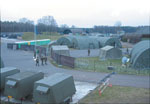Many Nations Linked Under One Command
 |
| The Allied Rapid Reaction Corps’ Command and Control Information System (ARRC C2IS) is designed to form the information backbone in deployed NATO headquarters. The system will consist of battle management and information sharing tools that will provide commanders with enhanced situational awareness and coalition networking interoperability. |
NATO Rapid Response Force commanders soon will benefit from equipment that provides enhanced situational awareness and battle management capabilities. The improvements are part of a package of networked decision-making tools scheduled to enter service in 2008 to support the force’s deployable headquarters.
The Allied Rapid Reaction Corps’ Command and Control Information System (ARRC C2IS) will form the information sharing and decision-making backbone of the alliance’s current rapid deployment force. Capable of spearheading global operations, the ARRC consists of a standing headquarters and a high readiness land force comprising up to four divisions and 20 brigades. The ARRC C2IS is designed to operate in the ARRC’s deployable land headquarters.
While it supports NATO’s Rapid Reaction forces, the ARRC C2IS program is managed and operated by the
The ARRC C2IS communications infrastructure consists of Falcon communications nodes (SIGNAL Magazine, October 2005), computing hardware provided by the ARRC Infrastructure (INFRA) program and Thales-produced command and control software. When it is deployed, the system will occupy several dozen tents in an ARRC headquarters. “It’s not a one-off mission. It’s real equipment for a complete headquarters with several hundred people,” he says.
Darmon explains that the system falls under the British government’s Network Enabled Capability (NEC) program. The NEC concept represents an operational chain to enhance actions and effects through improved internetworking and information sharing. Within the larger NEC effort, the Falcon and ARRC INFRA programs will provide the networking capability while the ARRC C2IS will supply commanders with enhanced information sharing and decision-making tools. He adds that the ARRC C2IS and the NEC will provide common, accurate and timely information sharing and coordination for multinational and coalition forces.
The ARRC C2IS program originated from a decision by the U.K. Ministry of Defence to launch a new-generation command and control information system. Thales and its partner firms Computer Sciences Corporation,
Darmon explains that the current ARRC C2IS capability was developed incrementally and includes physical infrastructure, operating systems and applications from a variety of legacy multinational systems. Moreover, as several British and European programs mature over the next eight years, they will be incorporated into the ARRC C2IS architecture. He also admits that changes in the ARRC headquarters’ concept of operations and the incremental technology developments have resulted in capability gaps.
Under the program, Thales seeks to improve the ARRC C2IS by providing systems to enhance a range of land command center (LCC)/corps-level operations. These functions include improved situational awareness and planning and flexible, integrated order generation and dissemination. The system also will coordinate and synchronize a variety of processes such as training and information management. When deployed, the ARRC C2IS will integrate databases and allow shared multinational information to be accessed, tracked and audited to provide commanders with enhanced situational awareness and services.
 |
| Engineered to support NATO Rapid Reaction Force headquarters at the corps and division levels, the ARRC C2IS system will use service-oriented architecture software for flexibility in accepting new applications and upgrades. |
After the contract award and the initial assessment phase, the program’s second phase, underway, is design development and delivery. An interservice operational phase is scheduled to begin in October 2007. The design phase consists of two steps: an initial operating capability demonstration set for March 2007 followed by a full operating capability in early 2008. Thales will deliver the command and control software based on service-oriented architecture (SOA) concepts (SIGNAL Magazine, April 2006, page 67). He shares that while the SOA does not provide a specific operational advantage, it does allow the entire system to be more adaptable to future modifications and upgrades. “It’s a pure internal, technical issue. It’s more for the future evolution and interoperability. But the user doesn’t see it,” he says.
The team developing the ARRC C2IS faced two challenges: interoperating with legacy systems and preparing for future NEC upgrades. The system will meet these needs through a global SOA that operates the European Committee for Interoperable Systems (ECIS) battle management system. Darmon adds that ECIS already is accredited for use in the NATO Rapid Reaction Force and features a multiuser architecture that is interoperable with most legacy coalition battle management equipment and software.
Web Resources
Thales: www.thalesgroup.com
U.K. Ministry of Defence: www.mod.uk
NATO Allied Rapid Reaction Corps: www.arrc.nato.int




Comments